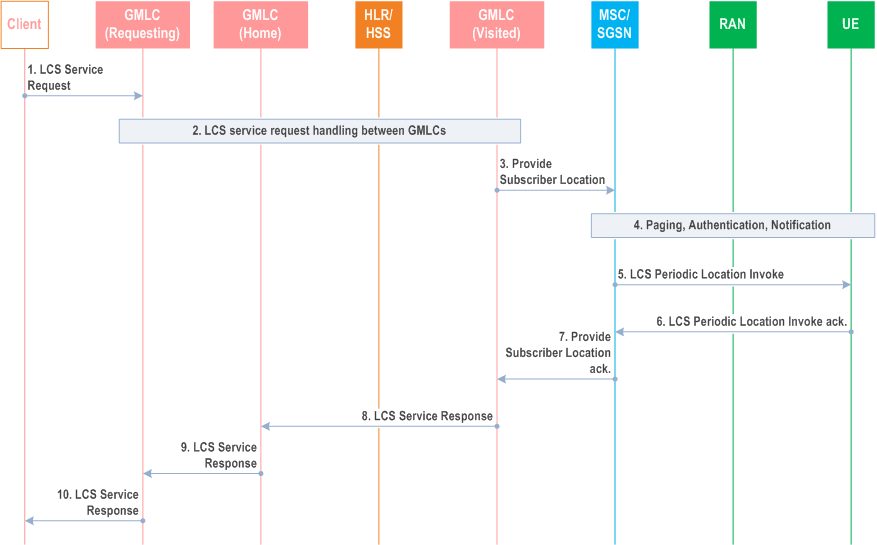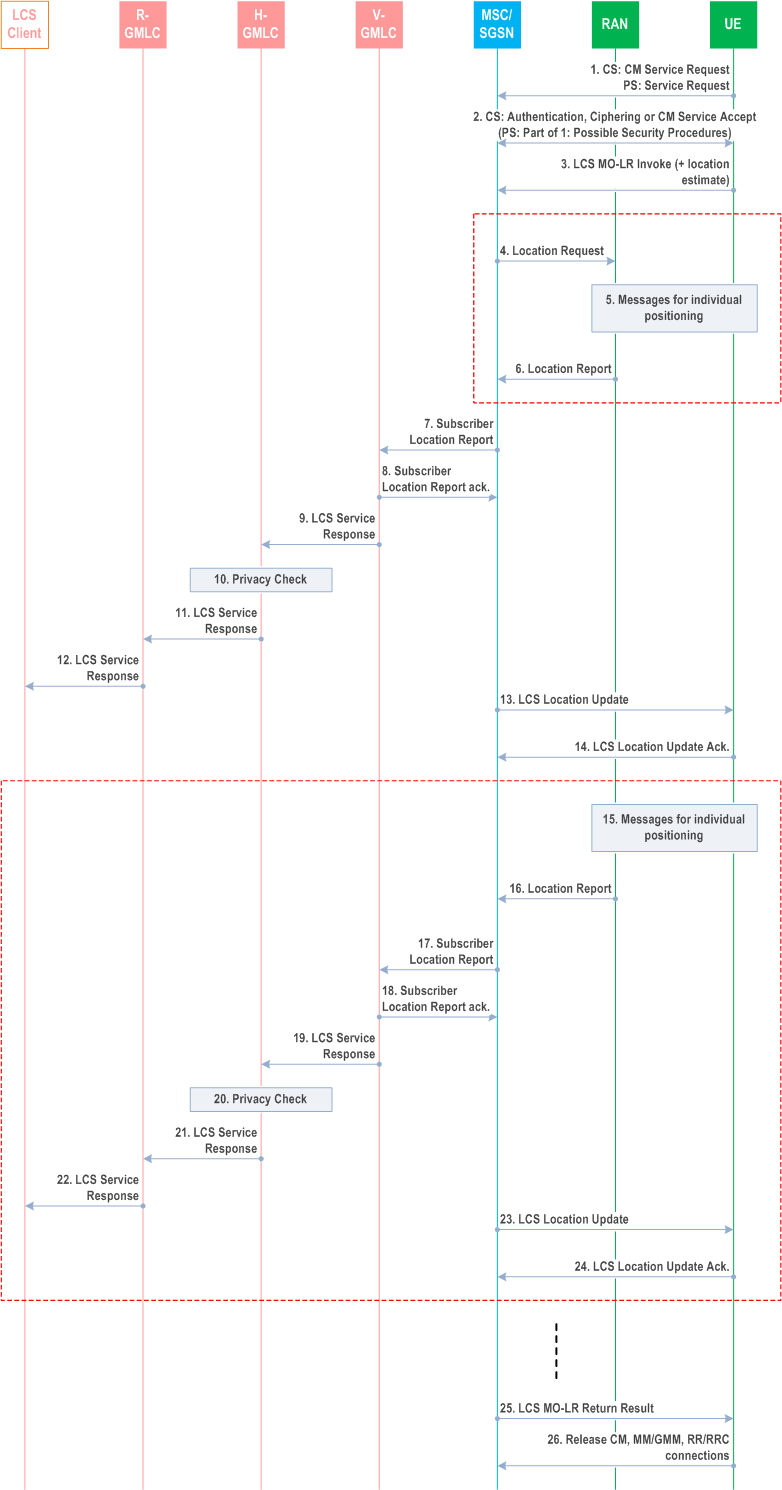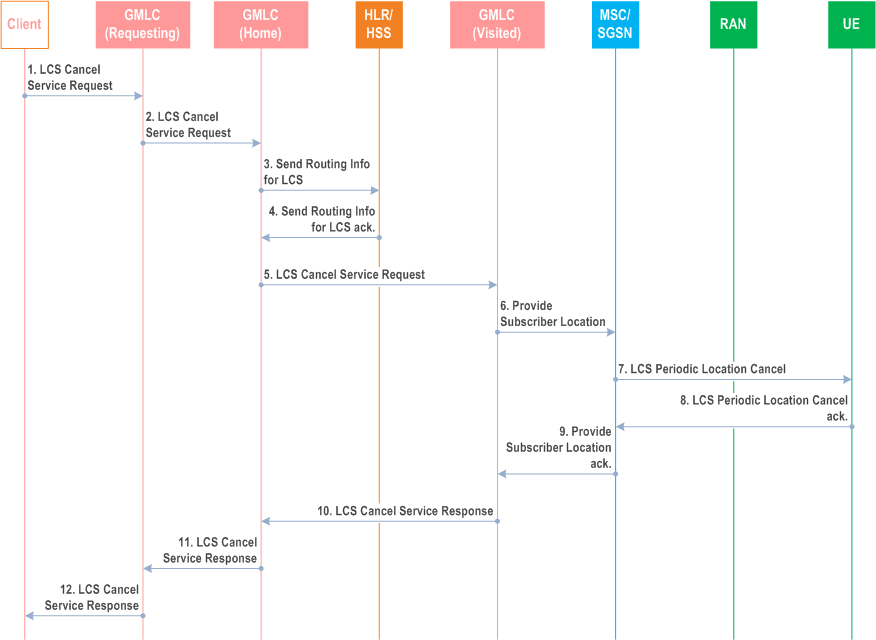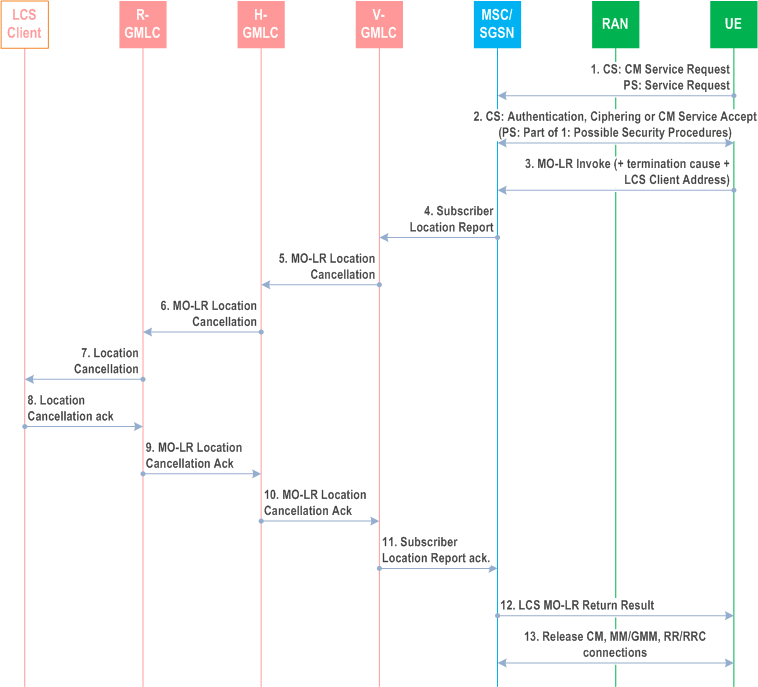Content for TS 23.271 Word version: 18.0.0
1…
5…
6…
6.2…
7…
8…
9…
9.1.1A…
9.1.2…
9.1.5…
9.1.6…
9.1.8…
9.1.9…
9.1.12…
9.1.13…
9.1.15…
9.1.19…
9.2…
9.2.2…
9.2.3…
9.3…
9.4…
9.5…
9.6…
10…
11…
A…
B…
E
F…
9.1.12 Deferred Location Request Procedure for the Periodic Location Event
9.1.12.1 Instigation of an MT-LR Request for Periodic Location
9.1.12.2 Reporting of Periodic Location
9.1.12.3 LCS Client cancellation of a Deferred Location Request - Periodic Location Event
9.1.12.4 UE cancellation of a Deferred Location Request - Periodic Location Event
...
...
9.1.12 Deferred Location Request Procedure for the Periodic Location Event |R7| p. 96
This clause describes the procedures for a Deferred Location Request where a Location Report is returned to the network each time the periodic reporting event occurs within the UE.
9.1.12.1 Instigation of an MT-LR Request for Periodic Location p. 96

Step 1.
The LCS Service Request contains the periodic location request information, such as time interval between successive location reports and total number of reports.
Step 2.
LCS service request handling between GMLCs as described in clause 9.1.1. The information received by the R-GMLC is transferred to the H-GMLC. The R-GMLC also indicates whether MO-LR Short Circuit is allowed.
The H-GMLC assigns a LDR reference number to this LCS Service Request and may include a list of PLMNs and possibly associated radio access technologies (e.g. GSM, UMTS), either prioritized or non-prioritized, in which subsequent MO-LR TTTP requests must be made by the UE (according to the procedure in clause 9.1.12.2) and an indication for each PLMN (and possibly associated radio access technology) as to whether the PLMN supports periodic location in the RAN. If no list is included by the H-GMLC, subsequent MO-LR TTTP requests are restricted to the current serving PLMN only. The H-GMLC then transfers the information to the V-GMLC, including the LDR reference number, any reporting PLMN list and the H-GMLC address.
Step 3.
The V-GMLC conveys the periodic location request to MSC/SGSN in the Provide Subscriber Location request including the LDR reference number, any reporting PLMN list and the H-GMLC address in the request, as well as an indication of whether MO-LR Short Circuit is permitted.
Step 4.
The MSC/SGSN verifies the UE capabilities with regard to the support of location service related call independent supplementary services (e.g. notification for LCS). If either the UE does not support any location service related call independent supplementary service or the MSC/SGSN does not support the deferred location request for the periodic location event (for temporary or permanent reasons), a Provide Subscriber Location return error shall be returned with a suitable cause in step 7.
If the UE is in idle mode, the core network performs paging, authentication and ciphering. If privacy notification/verification is requested, the MSC/SGSN sends an LCS Location Notification Invoke message to the target UE with a location type indicating activation of a deferred location request, a deferred location event type indicating periodic location and an indication as to whether privacy verification is required. LCS Location Notification is further specified in clauses 9.1.2 and 9.1.6. If privacy verification was requested, the UE returns an LCS Location Notification Return Result to the MSC/SGSN indicating whether permission is granted or denied. If a previous deferred location request is ongoing in the UE and the MSC/SGSN proceeds with the current deferred request, the UE may return an LCS Location Notification Return Error response to the MSC/SGSN indicating that the new request cannot be supported.
Step 5.
The MSC/SGSN sends an LCS Periodic Location Invoke to the UE containing the periodic location related parameters (reporting interval and total number of reports) and other relevant information (QoS, LCS Client External ID, H-GMLC address, LDR reference number, any reporting PLMN list and use of MO-LR Short Circuit).
Step 6.
If the LCS Periodic Location Invoke is successfully received by the UE and the UE supports the periodic location according to the request received in step 5, the UE sends an acknowledgement to MSC/SGSN including the MO-LR Short Circuit indication if received in step 5. If the MO-LR Short Circuit indication is received in step 5 and the UE does not support MO-LR Short Circuit (for temporary or permanent reasons), the UE sends the LCS Periodic Location Invoke Ack without the MO-LR Short Circuit indication indicating to the MSC/SGSN that MO-LR Short Circuit will not be used. If a previous deferred location request is still ongoing in the UE, the UE may return an LCS Periodic Location Return Error response to the MSC/SGSN indicating that the new request cannot be supported.
Step 7.
If either the MSC/SGSN or the UE does not support the periodic location request (for temporary or permanent reasons), a Provide Subscriber Location return error shall be returned to the V-GMLC with a suitable error cause.
If both of the MSC/SGSN and UE supports the periodic location request, a Provide Subscriber Location Ack. shall be returned to the V-GMLC. The MSC/SGSN shall include an MO-LR Short Circuit indication in the response to the V-GMLC, if the use of MO-LR Short Circuit was requested and accepted by the UE in step 6.
Step 8) to 10.
The V-GMLC returns the LCS Service Response via H-GMLC and R-GMLC to the LCS Client to notify whether the periodic location request was successfully accepted or not. When the H-GMLC returns the LCS Service Response to the R-GMLC, the LDR reference number assigned by the H-GMLC shall be included, and the R GMLC may transfer the LDR reference number to the LCS Client in the LCS Service Response.
9.1.12.2 Reporting of Periodic Location p. 98
Once the periodic location reporting has been successfully instigated using the procedure in Figure 9.12 (or Figure 9.8a in case the UE subscriber or an application in the UE is the instigator), the UE is responsible for sending location estimates periodically to the LCS Client using MO-LR TTTP procedure illustrated in Figure 9.13 below. This procedure begins immediately or, in the case of MO-LR short circuit, almost immediately after the procedure in Figure 9.12 (or Figure 9.8a) and continues until the specified number of reports for this request is attained or the procedure is cancelled by the UE, R GMLC or H GMLC using the procedure specified in clause 9.1.12.3.

Step 1) to 2.
If the UE is in idle mode, the UE requests a radio connection setup and sends a CM Service Request indicating a request for call independent supplementary service to the VMSC/MSC server via RAN (CS domain). If the UE is in dedicated mode, the UE sends a CM Service Request on the already established radio connection. The VMSC/MSC server instigates authentication and ciphering if the UE was in idle mode or returns a CM Service Accept if the UE was in dedicated mode.
For PS domain, in UMTS, if the UE is in idle mode, the UE requests a PS signalling connection and sends a Service Request indicating signalling to the SGSN via RAN. If the UE already has PS signalling connection, the UE does not need to send the Service Request. Security functions may be executed. These procedures are described in TS 23.060. In GSM this signalling step is not needed.
Step 3.
The UE sends an LCS MO-LR Invoke to the VMSC/MSC Server (CS domain) or to the SGSN (PS domain) for a transfer of the location estimate to a third party LCS client. This message includes the identity of the LCS client and the H-GMLC address received by the UE during execution of the procedure described in clause 9.1.12.1 (or clause 9.2.3).
The LCS MO-LR Invoke also includes the LDR Reference Number. The presence of the LDR Reference Number indicates that the transfer and its attributes (e.g. use of MO-LR Short Circuit) have been previously authorized by the R-GMLC, H-GMLC and V-GMLC, using the procedure described in clause 9.1.12.1 (or clause 9.2.3).
This message also includes a location estimate if MO-LR Short Circuit was requested and has been acknowledged by the UE. If MO-LR Short Circuit has been acknowledged and the UE was not able to obtain a location estimate, the LCS MO-LR Invoke shall still be sent when the reporting event occurs indicating that no location estimate is available.
If MO-LR Short circuit has not been agreed or was not requested, the LCS MO-LR Invoke message does not include any location estimate or error indication, but includes QoS information and optional periodic location information (reporting interval and number of reports), as well as an optional request for location update notification (see steps 13 and 14).
Step 4) to 6.
If MO-LR Short Circuit is not used (i.e. no location estimate or no error indicating unavailability of a location estimate is included in step 3), the MSC/SGSN obtains a location estimate by sending a Location Request to RAN associated with the target UE in step 4. The Location Request includes the LCS QoS. If supported by the serving RAN and included by the UE in step 3, the Location Request can include periodic location information (e.g. reporting interval and number of reports). In step 5, RAN determines the positioning method and instigates the particular message sequence for this method, as specified in UTRAN Stage 2, TS 25.305 and GERAN Stage 2, TS 43.059. When a location estimate best satisfying the requested QoS has been obtained, RAN returns it to the MSC/SGSN in a Location Report message in step 6.
Step 7.
If a location estimate has been received from the UE in step 3 (i.e. use of MO-LR Short Circuit) or was successfully obtained in step (6), the MSC/SGSN sends a Subscriber Location Report to its associated V-GMLC with an indication of the periodic event occurrence, the LDR reference number, the H-GMLC address and may also include the indication whether the obtained location estimate satisfies the requested accuracy or not (provided that this indication is obtained from RAN or the UE with the location estimate). If no location estimate was obtained in step 3 or 6 (e.g. positioning failure or time out), a report indicating this shall be returned.
Step 8.
The V-GMLC sends an acknowledgement to the MSC/SGSN and the MSC/SGSN may record charging information.
Step 9.
The V-GMLC sends an LCS Service Response to the H-GMLC with an indication of the periodic event occurrence, the LDR reference number and the location estimate if this was successfully obtained. If the location estimate could not be obtained, the V-GMLC sends the LCS Service Response without the location estimate. The LDR reference number will be used by the H-GMLC to identify the source of the original periodic location request. The V-GMLC may record charging information.
Step 10.
The H-GMLC may perform a privacy check as described in clause 9.1.1.
Step 11.
The H-GMLC sends an LCS Service Response to the R-GMLC with an indication of the periodic event occurrence, the LDR reference number and the location estimate if this was successfully obtained. If the location estimate could not be obtained, the H-GMLC sends the LCS Service Response without the location estimate. If this is the final location report, the periodic location request shall be completed in the H-GMLC. The H-GMLC may record charging information.
Step 12.
The location information is passed to the LCS Client. If this is the final location report, the periodic location request shall be completed in the R-GMLC. The R-GMLC may record charging information.
Step 13) to 14.
If periodic reporting in the RAN was instigated in step 4 and location update notification was requested in step 3, an LCS Location Update is sent to the UE to indicate successful transfer of the first location estimate (or possibly transfer of a location failure report) towards the LCS Client. The UE acknowledges this. The UE may employ the LCS Location Update ack. to cancel the procedure (see Note 2).
Step 15) to 24.
If periodic reporting in the RAN was instigated in step 4, RAN obtains a new location estimate in step 15 and transfers this to the MSC/SGSN in step 16 after the reporting interval has transpired. The MSC/SGSN transfers the location estimate to the LCS client in steps 17 to 22. Steps 17 to 22 are as in steps 7 to 12. An LCS Location Update is then sent to the UE in step 23 and acknowledged in step 24 if requested in step 3. Steps 23 and 24 are as in steps 13 and 14. Steps 15-24 are repeated at the periodic location interval (as the RAN provides each new location estimate to the MSC/SGSN) until the number of reports is attained, or until there is a request from the RAN to hand the UE over to a different MSC/SGSN. Following transfer of the final location estimate to the LCS Client, the transfer and acknowledgment of an LCS Location Update in steps 23 and 24, if requested in step 3, could be omitted as an implementation option.
Step 25.
The MSC/SGSN returns an LCS MO-LR Return Result to the UE indicating that the location estimate (or location estimates in case of periodic reporting in RAN was instigated at step 4 has been successfully transferred to the LCS client or not.
Step 26.
The MSC/SGSN may release the CM, MM or GMM and radio connection to the UE, if the UE was previously idle.
The UE is responsible for restarting the procedure at step 1 or 3 if the total number of location reports has not yet been reached. In the case of restarting at step 3, the CM, MM/GMM and radio connections would not be released.
If the UE moves out of coverage of the PLMN(s) in which the location reports are allowed or if a conflict with the PLMNs preferred by the UE for other services prevents access to the PLMN(s) for periodic location, the UE terminates the procedure and stops sending LCS MO-LR Invoke. The UE may determine the need for termination if it is unable to instigate an MO-LR TTTP request for some period of time (e.g. some multiple of the required periodic location interval).
If any LCS MO-LR Invoke TTTP request is rejected by the current serving PLMN with a cause indicating that the procedure cannot be supported (for temporary or permanent reasons) - e.g. MO-LR Short Circuit was initially agreed, but can no longer be supported or cannot be supported in the new PLMN - and the UE is unable to instigate the procedure in any other PLMN allowed when the procedure was originally started, the UE terminates the procedure and stops sending LCS MO-LR Invoke TTTP requests.
9.1.12.3 LCS Client cancellation of a Deferred Location Request - Periodic Location Event p. 101
Figure 9.14 illustrates the procedure for cancelling the Deferred Location Request for the periodic location event when cancellation is requested by the LCS Client.

Step 1.
The LCS Client requests the cancellation of a previously requested Deferred Location Request. The LDR reference number that was included in the previous LCS Service Response sent by the R-GMLC shall be included in the request to indicate which outstanding LDR should be cancelled.
Step 2.
The R-GMLC sends the cancellation request to H-GMLC, including the LDR reference number. The R GMLC may itself initiate the cancellation for some other reason, e.g. whenever the R-GMLC infers from the absence of periodic location reports that the service may have been terminated.
Step 3.
The H-GMLC may send a SEND_ROUTING_INFO_FOR_LCS message to the home HLR/HSS of the UE with the IMSI or MSISDN of this UE. This may be needed if the UE may no longer be served by the original V PLMN or by the original SGSN or VMSC/MSC server.
Step 4.
The HLR/HSS returns the current SGSN and/or VMSC/MSC server for the UE and the V-GMLC address.
Step 5.
The H-GMLC forwards the LCS Cancel Service Request to V-GMLC with the LDR reference number which is received from the R-GMLC, the H-GMLC address and the SGSN or VMSC/MSC server address (e.g. received from the HLR/HSS). The H-GMLC may itself initiate the cancellation procedure, when the UE's privacy profile stored in the H-GMLC or in the PPR was changed. For every outstanding Deferred Location Request against that UE, the H-GMLC shall perform or ask the PPR to perform a new privacy check based on the updated privacy profile. If the new privacy check passes, i.e. the LCS Client is still allowed to position the target UE, the handling of the outstanding Deferred Location Request should be continued. Otherwise, if the new privacy check does not pass, i.e. the location estimate of the target UE is not allowed to be provided to the LCS Client, the H-GMLC shall initiate a cancellation procedure. If the H-GMLC cannot complete the new privacy check (e.g., because it requires information, such as UE location, not currently available to the H-GMLC), then the H-GMLC may initiate a cancellation procedure according to H-PLMN privacy policy.
Step 6.
The V-GMLC sends the Provide Subscriber Location request to MSC/SGSN, indicating a cancellation of a deferred location request and including the LDR reference number specified by the LCS Client in the LCS Cancel Service Request and the H-GMLC address received from the H-GMLC. The V-GMLC shall transfer the location cancellation even when the V-GMLC was not involved in establishing the periodic location request - e.g. if the target UE is now served by another V-PLMN.
Step 7.
The MSC/SGSN sends the LCS Periodic Location Cancellation request, including the LDR reference number and H-GMLC address, to the UE. If the periodic reporting is via the serving RAN as described in step 4 of Figure 9.13, the periodic location cancellation request is also sent to RAN.
Step 8.
The UE stops the periodic location reporting and returns the LCS Periodic Location cancellation ack. to the MSC/SGSN. Return of an LCS Periodic Location cancellation ack. shall apply even when the UE has no knowledge of the periodic location procedure being cancelled (e.g. UE was powered off during the procedure).
Step 9.
The MSC/SGSN sends the cancellation acknowledgement to the V-GMLC in the Provide Subscriber Location Ack, with the LDR reference number and the H-GMLC address.
Step 10.
The V-GMLC sends the LCS Cancel Service Response to H-GMLC with the LDR reference number and the H GMLC address.
Step 11.
H-GMLC sends the LCS Cancel Service Response to R-GMLC with the LDR reference number.
Step 12.
R-GMLC sends the LCS Cancel Service Response to the LCS Client.
9.1.12.4 UE cancellation of a Deferred Location Request - Periodic Location Event p. 103
Figure 9.15 illustrates the procedure for cancelling the Deferred Location Request for the periodic location event when cancellation is requested by the UE. If a network entity (e.g. H-GMLC, V-GMLC, SGSN/MSC) cancels the Deferred Location Request, the procedure in clause 9.1.12.3 for LCS Client cancellation shall be used to cancel towards the UE and the procedure in this clause shall be used to cancel towards the LCS Client.

Step 1) to 2.
If the UE is in idle mode, the UE requests a radio connection setup and sends a CM Service Request indicating a request for call independent supplementary service to the VMSC/MSC server via RAN (CS domain). If the UE is in dedicated mode, the UE sends a CM Service Request on the already established radio connection. The VMSC/MSC server instigates authentication and ciphering if the UE was in idle mode or returns a CM Service Accept if the UE was in dedicated mode.
For PS domain, in UMTS, if the UE is in idle mode, the UE requests a PS signalling connection and sends a Service Request indicating signalling to the SGSN via RAN. If the UE already has PS signalling connection, the UE does not need to send the Service Request. Security functions may be executed. These procedures are described in TS 23.060. In GSM this signalling step is not needed.
Step 3.
The UE sends an LCS MO-LR Invoke to the VMSC/MSC Server (CS domain) or to the SGSN (PS domain) for cancellation of a transfer of location to a third party LCS client. This message includes the identity of the LCS client, the H-GMLC address, a termination cause (e.g. subscriber terminates the procedure) and the LDR Reference Number. The presence of the LDR Reference Number indicates that the cancellation is for a previously authorized periodic location request.
Step 4) to 7.
The cancellation request shall be transferred in succession from the MSC/SGSN to the V-GMLC, H GMLC, R GMLC serving the LCS client and finally may be transferred to the LCS client (e.g. if the LCS Client originated the periodic location request or was informed of a periodic location request originated by the UE as in clause 9.2.3).
Step 8) to 11.
The response transferred back to the MSC/SGSN acknowledges the cancellation.
Step 12.
The MSC/SGSN returns the acknowledgment to the UE in a LCS MO-LR Return Result message.
Step 13.
The UE may instigate release of the CM, MM/GMM and radio connections.